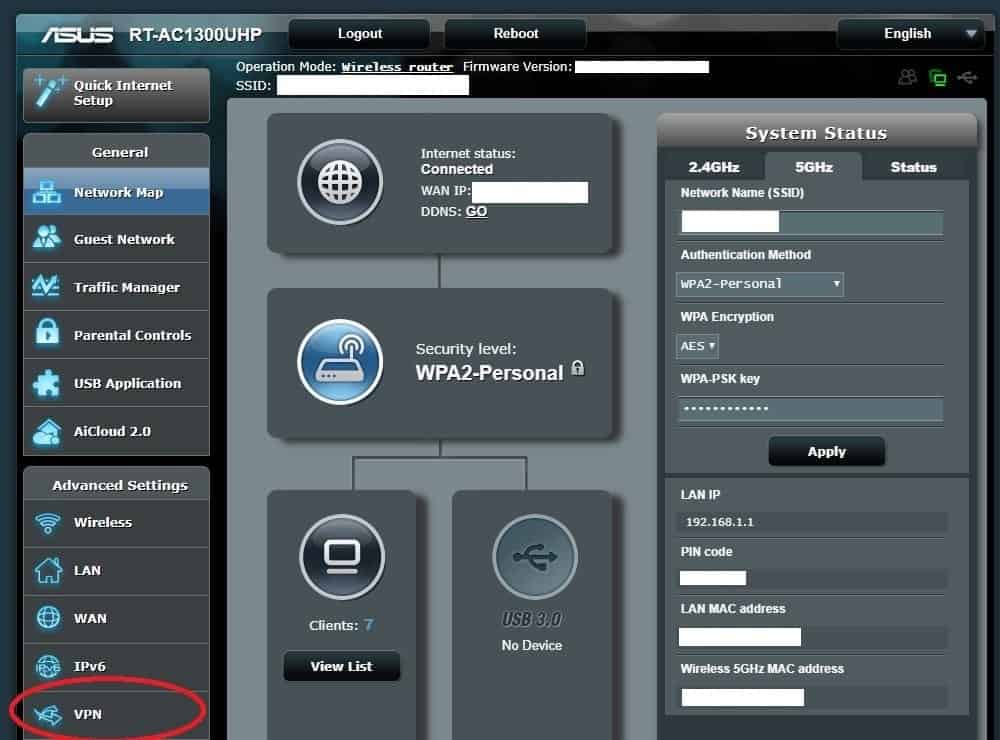
- #Ipsec vpn client windows 10 asus how to#
- #Ipsec vpn client windows 10 asus install#
- #Ipsec vpn client windows 10 asus password#
- #Ipsec vpn client windows 10 asus Offline#
- #Ipsec vpn client windows 10 asus free#
Leave the PowerShell console open and proceed with the next steps to generate a client certificate.Įach client computer that connects to a VNet using Point-to-Site must have a client certificate installed. CertStoreLocation "Cert:\CurrentUser\My" -KeyUsageProperty Sign -KeyUsage CertSign Subject "CN=P2SRootCert" -KeyExportPolicy Exportable ` $cert = New-SelfSignedCertificate -Type Custom -KeySpec Signature `

Then, run the following example with any necessary modifications. Sign in using the Connect-AzAccount cmdlet. You can view the certificate by opening certmgr.msc, or Manage User Certificates. The following example creates a self-signed root certificate named 'P2SRootCert' that is automatically installed in 'Certificates-Current User\Personal\Certificates'. Use the following example to create the self-signed root certificate. These examples do not work in the Azure Cloud Shell "Try It". For additional parameter information, see New-SelfSignedCertificate.įrom a computer running Windows 10 or Windows Server 2016, open a Windows PowerShell console with elevated privileges. Use the New-SelfSignedCertificate cmdlet to create a self-signed root certificate.
#Ipsec vpn client windows 10 asus install#
Once the certificates are generated, you can upload them, or install them on any supported client operating system. The Windows 10 or Windows Server 2016 computer is only needed to generate the certificates. The PowerShell cmdlets that you use to generate certificates are part of the operating system and do not work on other versions of Windows. You must perform the steps in this article on a computer running Windows 10 or Windows Server 2016.
#Ipsec vpn client windows 10 asus how to#
This article shows you how to create a self-signed root certificate and generate client certificates using PowerShell on Windows 10 or Windows Server 2016.
#Ipsec vpn client windows 10 asus Offline#
If one of the site has been offline for a while, for example, if Site A has been disconnected, on Site B you need to click Disable and then click Enable after Site A back on line in order to re-establish the IPSec tunnel.User VPN (point-to-site) connections use certificates to authenticate. The product supports a maximum of ten simultaneous connections.Ģ. If Ping proceeds successfully (gets replies from host in Site B), the IPSec connection is working properly now.ĥ.Now IPSec VPN is implemented to establish a connection.ġ. In the CLI window, type in “ping 192.168.2.x” (“192.168.2.x” can be IP address of any host in Site B). On the host in Site A, press + to open Run dialog. Tips: To check the VPN connection, you can do the following.ġ. You can ping site B’ LAN IP from your computer in site A to verify that the IPSec VPN connection is set up correctly. Refer to step 2 configuration on Site A and make sure that Site A and Site B use the same pre-shared keys and Perfect Forward Secrecy settings.Ĥ.Check the VPN connection. Note: The Status column is Down after the configuration, and it will change to UP only when Site A and Site B are communicating via the VPN connection.ģ.Configuration on Site B (remote network). Note: Make sure Site A and Site B use the same key.ĩ )Leave the Advanced Settings as default value. Then keep Perfect Forward Secrecy enabled. We select Auto(IKE) here.Ĩ )Enter the Pre-Shared Key for IKE authentication. Input the LAN IP range of Site B in the IP Address for VPN column, and input Subnet Mask of Site B.ħ )Select the Key Exchange Method for the policy. In the Tunnel access from remote IP addresses column, we take Subnet Address as an example.

Input the LAN IP range of Site A in the IP Address for VPN column, and input Subnet Mask of Site A. In the Tunnel access from local IP addresses column, we take Subnet Address as an example.
#Ipsec vpn client windows 10 asus password#
Record Site A and Site B’s LAN and WAN IP addresses before you start configuration.Ģ.Configuration on Site A (local network).ġ )Visit, and log in with your TP-Link ID or the password you set for the router.Ģ )Go to Advanced > VPN > IPSec VPN, and click Add.ģ )In the IPSec Connection Name column, specify a name.Ĥ )In the Remote IPSec Gateway (URL) column, Enter Site B’s WAN IP address. Site A refers to local network, and Site B refers to the remote network that is to be connected. Then, follow the steps below to set up an IPSec VPN connection.ġ.The typical VPN topology is here. To use IPSec VPN, you should check that both local and remote routers support IPSec VPN feature. IPSec VPN is used to create a VPN connection between local and remote networks. Use IPSec VPN to Access Your Home Network

Use IPSec VPN to Access Your Home Network.Make Xbox Online Games Run Smoothly by UPnP.
#Ipsec vpn client windows 10 asus free#


 0 kommentar(er)
0 kommentar(er)
